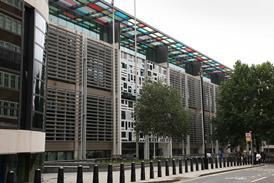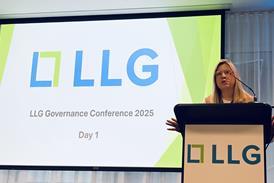The most common reaction to last week’s Ministry of Justice green paper on legal aid is shock. That shock is manifested among legal aid practitioners, clients and the groups that speak for clients.
The list of civil legal aid categories from which support may be withdrawn is long, and encompasses some of the most vulnerable people in society. What particularly irks many is that support for challenging official indifference and ineptitude – on the part of the police, councils and negligent doctors – could be withdrawn. As one barrister who advises on education and special needs cases, and asked to remain anonymous, puts it: ‘Basically, it’s an absolute disaster for the poor, particularly at a time when there will be increased levels of joblessness, large-scale changes to welfare benefits and a radical rethink of the housing benefit regime.’
The only nod to social justice is the ‘mercy’ shown to some categories – such as adults in care, victims of domestic violence or abuse, and asylum seekers. But this is ‘two-by-two’ politics, with selected species of social justice making it on to the Ark as all around is submerged.
Withdrawal symptomsThe presentation of the legal aid review, combined with the Jackson report on the costs of civil justice, has excluded or distanced some of the very interests that could have filled the void in some areas of current legal aid provision. Wholesale exclusion of public funding for many areas precludes innovation that could cut costs, while providing no access to legal services from any provider that is not insurer-linked or acting pro bono. And these last two constituencies have little time to react.
LawWorks chief executive Rebecca Hilsenrath identifies key ways in which pro bono provision will be damaged by the proposed cuts to legal aid. In addition to damaging the interests of the most vulnerable in society, she says: ‘Collaterally… the proposals also threaten the legal provider base, [specifically] the viability of the frontline of not-for-profit advice agencies, the capacity of many law firms and the existence of certain legal specialisms.’
That setup, Hilsenrath explains, is central to the provision of pro bono advice: ‘The delivery and coordination of pro bono, where so much has been achieved in the last decade, depends heavily on the existence of a strong frontline of not-for-profit advice agencies, on the reach of law firms, and on the continued supply of lawyers who are specialists in the area of law involved.’
There is also scepticism that mediation can replace the need for fully funded cases, as suggested for divorce in the green paper – not least among mediators. CEDR Solve director Tony Allen says: ‘Mediation is here to supplement the civil justice system and depends on it – no one is suggesting it is a substitute. It is complementary.’
That assessment is shared by the Law Society’s head of legal aid, Richard Miller. ‘Mediation works in the shadow of the courts,’ Miller argues. ‘But it doesn’t work if one party is unreasonable, and there is no quick way of enforcing against a party who does not hold up their side of the agreement that was reached.’
Vicky Ling, a consultant who advises legal aid practices, concurs: ‘With a family mediation, how do you give your agreement effect?’
The green paper is also badly received by those practitioners who agree that savings can be made in the delivery of legally aided advice. Adam Makepeace, practice director at Duncan Lewis, has been a leading advocate of reform, but is ‘upset by the rhetoric of the green paper and the way it was delivered’.
He adds: ‘The press release, for example, was very aggressive in attacking [undeserving] cases.’
And it is not just the presentation to which Makepeace takes exception: ‘What I was looking for in the report was an idea of how to retain as much provision as possible. I was looking for big ideas – not "slash and burn". But it is just that.’
A shift to advice delivered by telephone is one innovation the green paper proposes. The telephone already features in much advice, but there are instances where legal aid practitioners say it is simply inappropriate. ‘You usually need at least one client meeting,’ Gwendolen Morgan, a human rights and public law solicitor at Bindmans, argues. ‘Without reading clients’ reactions face-to-face it can be difficult to know that they have properly understood your advice.’
Not a successInsurers are central to the market that has developed around conditional fee agreements and litigation funding, and are known to be interested in developing products to fund some of the areas where legal aid could be withdrawn. Tort, probate and ancillary relief are obvious candidates for cases above a certain value.
But in many areas, Lord Justice Jackson’s report on the costs of civil justice, published on the same day as the green paper, proposes the removal of key incentives for insurers and law firms to bear the risk in cases. Jackson’s most controversial proposals concern the ‘success fee’ allowed in conditional fee agreements, which arguably means that a claimant’s law firm has no incentive to keep costs down. This is criticised in defamation cases, where the media lobby says this makes cases too expensive – with cost considerations creating an environment which damages free speech and investigative journalism.
The main controversy comes in Jackson’s application of this thinking to other areas where CFAs are used, such as personal injury. He would like to see a 10% rise in the award, but have the success fee recovered from the claimant, not the defendant. Association of Personal Injury Lawyers (APIL) president Muiris Lyons argues: ‘The only party to benefit from this proposal is the negligent person, and through him his insurer, who will have collected a premium to cover such costs. The interests of insurance companies and negligent defendants must not outweigh the rights of injured people.’
The legal aid green paper and Jackson review response constitute a ‘double whammy’, says Lyons: ‘Jackson is a levy on injured people, who would subsidise the defendant’s insurers.’
Richard Harries, partner and head of clinical negligence at Barcan Woodward, also believes Jackson is misguided: ‘If, as proposed, after-the-event premiums and success fees are going to be paid out of the claimant’s damages in successful cases, the suggestion that an increase in general damages will fund this cost is wrong-headed.’ He adds: ‘The idea comes very close to imposing contingency fees [as] adopted in the US. This only works there because much higher awards of damages are commonly decided by juries who make allowances for the [lawyer’s] costs.’
There is also frustration that Jackson’s focus did not include the behaviour of defendants and defendant insurers in increasing costs. Susan Brown, director at ProLegal is highly critical: ‘The starting point in his attempts to reduce the costs of PI claims to insurers overlooks the fact that adequate procedures are already in place – if defendant lawyers and insurers collaborate to apply them.’
The fixed costs regimes should prevent costs from escalating unnecessarily, Brown points out: ‘However, insurers have failed to make their claims departments efficient enough to deal with claims within the existing protocols and time limits.’ The result, she says, is that claimant parties often run up excessive costs by taking claims to court when ‘insurers are failing to keep up their side of their bargain’.
Not all parts of Jackson are so badly received. Jackson also considers the introduction of ‘qualified one-way costs shifting’ in some categories, including personal injury and medical negligence. Under these proposals, most losing claimants would not bear the other side’s costs – long seen as a deterrent to access to justice. The question is whether this boost for ‘access’ is a sufficient counterweight to the problems caused by the withdrawal of legal aid in some categories, and changes to the success fee.
Getting outThe consultation process on the green paper runs until 14 February 2011 and lawyers who work in areas where withdrawal of legal aid funding is proposed are already working out the implications for their own future. Many tell the Gazette privately that they are committed to remaining in publicly funded work, but say that their practice will inevitably refocus. In housing, that means working only for clients who are at the stage of facing homelessness; family lawyers will shift to cases where there is domestic violence; and immigration lawyers will focus on clients who are in detention, or are facing detention.
The result will be a change in the mindset of advisers who do legal aid work, taking the emphasis away from early resolution of problems. Morgan is one of many lawyers to make the point that ‘there is an economic value to early advice’. Hilsenrath concurs: ‘Early intervention reduces the likelihood of serious problems developing subsequently. Initial advice helps to build capacity by helping more legally literate clients to help themselves and by ensuring that proper referral systems are in place.’
Morgan says the flight of expertise and funds will have a ‘serious impact’ on public law. Although judicial review remains in scope for certain public law challenges, ‘a severe reduction in the current hourly rates to the "risk rates" once a permission decision has been made at first instance’ will put many firms’ survival at risk and leave clients without representation.
The legal aid proposals also embody a fundamental shift in public policy that is not explicitly flagged. Private actions against businesses and public bodies have a role to play in improving the quality of services and decision-making. In other areas of government policy – competition law and financial services regulation, for example – the role played by liability in promoting good practice is increasingly recognised. There is no recognition in the green paper that the support of legal aid has any such function, even where the sums involved are small. ‘What is shocking,’ Miller notes, ‘is to find small-figure categories such as education cases or support for disabled children included in a list of proposed cuts’.
For areas that continue to attract funding, proposed changes to eligibility for legal aid are a huge concern. The group Young Legal Aid Lawyers says: ‘Proposals to lower the limit for eligibility to £1,000, including equity in homes, will leave many without the ability to enforce their legal rights. Where funding does continue, there will be a 10% cut in fees across the board at a time when lawyers are already struggling to ensure good-quality advice for their clients while remaining financially viable.’
Naive assumptionOne of the most contentious areas of funding withdrawal is clinical negligence. The long time-span of many clinical negligence actions means that financing, even in cases with a high prospect of success, is a significant challenge.
‘To assume that market forces will fill the gap in clinical negligence matters is naïve,’ Harries says. With the exception of clients who are trade-union funded, experience of the market demonstrates that the potential for insurer-backed actions is limited, he says, adding: ‘The sad fact is that those people who can afford before-the-event policies often find themselves denied access to justice on the basis that some insurance companies seek to exclude valid and worthy claims on a militant interpretation of the [policy] terms.’ He cites the example of BTE companies that seek to exclude funding for claims involving misdiagnosed cancer as this is not ‘a specific or sudden event’. ‘Others,’ he adds, ‘are required to incur considerable costs in investigating the claim and obtain counsel’s advice before the case will be considered.’
The legal aid green paper seems to falter in its resolve when it comes to ‘obstetric cases’, a category which includes people brain-damaged through the mismanagement of pregnancy or birth. The complexity involved in such cases is acknowledged in the green paper, and their proposed exclusion may be reconsidered. But there are unlikely to be other exceptions. Harries says this creates a wider problem in respect of the accountability and quality of public services: ‘Being able to bring appropriate claims is vital for individual victims of medical mishaps, but also a hugely powerful force behind ensuring health and safety in our hospitals and GP surgeries.’
One area where many legal aid practitioners would have been willing to see bold reform proposals is in the way legal aid is funded, in addition to general taxation. Here the green paper proposes a levy on the interest law firms earn from client money held on account. But critics say that, at current interest rates, this is a deeply unreliable source of funds.
The creation of a ‘conditional legal aid fund’ has been mooted but is not in the legal aid green paper. Here, a proportion of the profits of CFA cases would go back in to the fund. What practitioners would like to see here, but the Ministry of Justice seems unwilling to consider, is new funding being used to maintain access to legal aid for some of the categories from which the green paper suggests removing eligibility.
Justice secretary Ken Clarke’s response to what are bound to be closely argued and impassioned submissions from the profession and others will be instructive in this respect. If the idea that new funding from sources other than general taxation could be used to maintain or restore eligibility is rejected out of hand, then MoJ policy starts to look less like an exercise in cost-cutting, and more like a concerted attempt to weaken the accountability of public bodies to vulnerable people by hobbling the advisers who currently speak for them. If that turns out to be the case, then what Ling calls her ‘deep shock and horror’ on first reading the legal aid green paper will have been entirely justified.
The Ministry of Justice green paper on legal aid proposes the removal of funding from the following areas:
- Housing (except homelessness)
- SEN (special educational needs)
- Ancillary relief
- Cases against public authorities
- Clinical negligence
- Consumer law
- Criminal injuries compensation
- Education
- Employment
- Children
- Appeals on tribunal decisions
- Some immigration cases
- Asylum support
- Probate
- Copyright
- Tort
- Welfare (appeals against removal of benefits)
- Challenges to forfeiture orders
- £2bn: the current legal aid budget
- 10%: the cut in fees for civil and family cases
- 265,000: the number of family cases a year that will no longer receive legal aid
- £350m: planned savings from the legal aid budget by 2014/15
- 0%: the proposed new London weighting for legal aid work
- 10%: the uplift in awards Lord Justice Jackson proposes if success fee is not recoverable
The proposals in the government’s green paper on legal aid and on the Jackson report on civil litigation represent a real threat to equal access to justice and thus to the rule of law, writes Linda Lee.
For cases which cannot be funded by conditional fees, the proposals create a very real risk that access to legal redress will effectively become impossible for the great majority of ordinary people in England and Wales. Perhaps most disturbingly, the proposals are driven not merely by a determination to reduce public expenditure, but by an explicit challenge to the values which have underpinned the development of legal aid over 60 years. Up to now, those values have been shared by all political parties.
Indeed, it is difficult to make a case in purely financial terms for cutting legal aid. The financial eligibility criteria are already so tight. Contrary to newspaper myths, over the last 10 years legal aid has grown far less than public expenditure generally – by under a third, whereas public expenditure as a whole has risen by over 90%. We have to go back to the 1990s to find a period in which legal aid persistently rose faster than public expenditure generally. Even now, legal aid amounts to under half of 1% of public expenditure – so it is barely relevant in terms of the government’s wish to reduce the deficit.
The government suggests that legal aid presently funds cases which are brought only because legal aid is funding them. Of course, that is true. But that does not mean, as the government seems to imply, that these are in some sense frivolous cases. They are cases of enormous importance to the individuals concerned, which cannot be resolved without litigation, and where the merits of that litigation have been carefully assessed by an independent authority.
The proposals are particularly serious for clinical negligence cases. The very large costs and great uncertainty of many of these cases make them very difficult to fund on conditional fees, even now. In future, if the government implements the Jackson recommendations that after-the-event insurance premiums and success fees should no longer be recoverable, funding them on conditional fees will become even more difficult. And yet these cases are vital, not only to ensure proper financial support for patients, but also to ensure that lessons are learned and to drive improvements in patient safety.
Solicitors across England and Wales will be aware of the waste in the court system, in the administration of legal aid, and in other public services, which contributes so significantly to legal aid costs. The Law Society has already issued an initial campaign brief to help solicitors engage their MPs. We will update that as the campaign progresses. We will ensure that we work closely with practitioners and others concerned with legal aid and civil justice, to get the message across.
The green papers are a start of the process, not the final word. They are consultation documents. In many cases implementation will require primary legislation. As a society, we have a choice. We can either reaffirm our determination to achieve equal access to justice, or we can retreat to the narrow vision set out in the green papers. The profession’s commitment to upholding justice and the rule of law means that our choice is clear. I hope all solicitors will work with the Law Society as our campaign to improve our justice system continues.
Linda Lee is president of the Law Society



























No comments yet